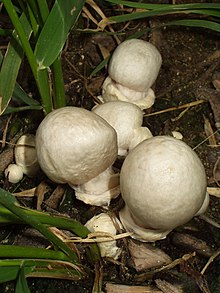The idea for a dry pumpkin pancake mix came from two directions. One, our family camps frequently in the warm months. We like to cook, to eat homemade meals, so because of that we choose to cook during vacations and weekend camping trips. At least most of the time. Our kids love pancakes so we tried the "just add water and shake" pancake mix in a jug. That gave me the idea for a homemade dry pancake mix. We could make this better. I was sure it was possible, even when I couldn't find much information on how to do it via internet searches and recipe book thumb-throughs. Joe and I were already pretty good at making pancakes, so I pieced together a few of our recipes to include dry versions of wet ingredients (eggs and milk) in order to reduce the amount of liquid that would have to be added to the dry mix during preparation.
The second part of the recipe, the pumpkin part, came while casually shopping in a roadside store that sold local produce and flowers, souveniers, and a few grocery items, including a deli counter, old fashoned candy and spices. Neat place. One of the items for sale was a pumpkin muffin mix. There had to be pumpkin in there. It was a dry mix, so the pumpkin was dried. Conveniently, it was autumn and pumpkins were in no short supply. Back at home and armed with a pressure cooker, food dehydrator and vitamix blender I was able to produce pumpkin powder. I added it to the recipe and with a few tweaks, pumpkin pancake mix was created. See how we made pumpkin powder here.
When the winter holidays arrived Joe, Marie, Mack and I decided to share this mix with our friends and relatives. Once a week the four of us share a "big breakfast", which for us means we have a meal that takes time and effort to create and brings us all to the table to eat, share stories or jokes, talk about things we've done in the week, or introduce new ideas for the kids. It is time spend living with and loving each other. To share that experience, that connection with others, we sent a package of pancake mix to dear friends.
Pumpkin Pancake Mix:
1 cup flour (wheat or buckwheat)
1/4 cup cornmeal
2 Tablespoons pumpkin powder (or 1/2 cup pumpkin puree for wet mix)
2 Tablespoons flax meal
1 Tablespoon sugar
2 tsp dried egg white (or 1 egg for wet mix)
4 Tablespoon buttermilk powder (or 1/2 - 1 cup milk/buttermilk/whey for wet mix)
2 tsp baking powder
1/2 tsp baking soda
1/8 tsp salt
1/2 tsp cinnamon
1/4 tsp ginger
1/8 tsp cloves
1/8 tsp nutmeg
Wet Ingredients:
2 cups water (or to desired batter thickness)
1 tsp vanilla
1 Tablespoon oil (optional)
Want to see how I made pumpkin powder? See the post here http://familyeggers.blogspot.com/2014/04/pumpkin-powder.html














































